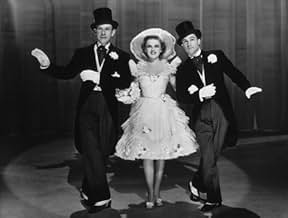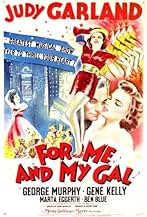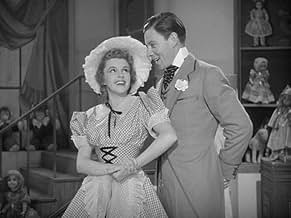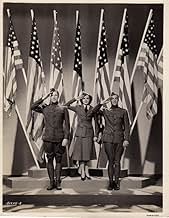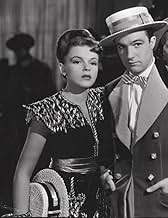VALUTAZIONE IMDb
7,0/10
4051
LA TUA VALUTAZIONE
Aggiungi una trama nella tua linguaTwo vaudeville performers fall in love, but find their relationship tested by the arrival of WWI.Two vaudeville performers fall in love, but find their relationship tested by the arrival of WWI.Two vaudeville performers fall in love, but find their relationship tested by the arrival of WWI.
- Regia
- Sceneggiatura
- Star
- Candidato a 1 Oscar
- 4 vittorie e 1 candidatura in totale
Mártha Eggerth
- Eve Minard
- (as Marta Eggerth)
Stephen McNally
- Mr. Waring
- (as Horace McNally)
Ernie Alexander
- Theater Workman with Big Die
- (non citato nei titoli originali)
Hooper Atchley
- Assistant Stage Manager
- (non citato nei titoli originali)
Walter Baldwin
- Bill
- (non citato nei titoli originali)
Gurney Bell
- Member - Sportsmen Quartet
- (non citato nei titoli originali)
John Breen
- Soldier
- (non citato nei titoli originali)
Ken Darby
- Member - The King's Men
- (non citato nei titoli originali)
George Davis
- France Taxi Driver
- (non citato nei titoli originali)
Bill Days
- Member - Sportsmen Quartet
- (non citato nei titoli originali)
John Dilson
- Lou
- (non citato nei titoli originali)
Jon Dodson
- Member - The King's Men
- (non citato nei titoli originali)
Lester Dorr
- Stage Manager
- (non citato nei titoli originali)
Ruth Dwyer
- Nurse
- (non citato nei titoli originali)
Recensioni in evidenza
Gene Kelly makes his smashing screen debut in For me and my gal. That alone should make it a must see. This movie was a delight for numerous reasons. First, I like the fact that this movie was a musical/drama. So, we were able to get a full dose of the manifold talents of Gene Kelly and Judy Garland. Second, the chemistry that Judy and Gene had in this movie was exceptional. The scene in which they are singing the title song is riveting. George Murphy was solid in his role as the amiable friend and colleague, who was a good example of selflessness.
This movie is not as renowned as other Garland classics such as the wizard of Oz and Meet me in St. Louis. However, I think this was her most endearing role. She was beautiful, sweet and vivacious in this movie. I can watch this movie repeatedly, and so should everyone else.
This movie is not as renowned as other Garland classics such as the wizard of Oz and Meet me in St. Louis. However, I think this was her most endearing role. She was beautiful, sweet and vivacious in this movie. I can watch this movie repeatedly, and so should everyone else.
This was Gene Kelly's first foray into film, thanks to Judy Garland. Judy herself is only three years beyond "The Wizard of Oz" and at the top of her talents. Their pairing alone makes this a film worth seeing. Now, when we hear their voices harmonizing---especially in the title song---it feels iconic.
This is really two films joined together. The first part is the story of vaudeville, and an opening dedication page says that. As their characters, Jo and Harry, meet, team up and struggle to make the big time, the viewer is regaled by song and dance, specialty acts and vaudevillian humor. George Murphy plays the part of Jimmy Metcalf, who winds in and out of their lives.
The action takes place in 1916, just before the U. S. enters WWI. When the RMS Lusitania is sunk, the tenor and style of the film changes. Audiences in 1942 could identify with the patriotic fervor depicted, and it stimulated their nationalistic impulses to buy war bonds, participate in various drives, and forgo many luxuries. The second section of the film, much of which is a montage, is designed to stir up a unified American response to the Axis powers. So, there is no discussion of isolationism or Washington's warnings against foreign entanglements, though they might have been authentic.
In that second section, Jo and Harry's story is secondary to the bigger national story, but it is still there. Unfortunately, the dramatic transition between the two parts is thematically disruptive. It's a criticism that filmgoers of the forties would not have lodged. The review by the New York Times, in its roundabout way, does find fault with the script and its tale of two stories.
Martha Eggerth, the soaring soprano, plays a small role that is notable because she seldom appeared in films west of the Atlantic.
This is a film worth seeing, especially as an example of wartime cinema.
This is really two films joined together. The first part is the story of vaudeville, and an opening dedication page says that. As their characters, Jo and Harry, meet, team up and struggle to make the big time, the viewer is regaled by song and dance, specialty acts and vaudevillian humor. George Murphy plays the part of Jimmy Metcalf, who winds in and out of their lives.
The action takes place in 1916, just before the U. S. enters WWI. When the RMS Lusitania is sunk, the tenor and style of the film changes. Audiences in 1942 could identify with the patriotic fervor depicted, and it stimulated their nationalistic impulses to buy war bonds, participate in various drives, and forgo many luxuries. The second section of the film, much of which is a montage, is designed to stir up a unified American response to the Axis powers. So, there is no discussion of isolationism or Washington's warnings against foreign entanglements, though they might have been authentic.
In that second section, Jo and Harry's story is secondary to the bigger national story, but it is still there. Unfortunately, the dramatic transition between the two parts is thematically disruptive. It's a criticism that filmgoers of the forties would not have lodged. The review by the New York Times, in its roundabout way, does find fault with the script and its tale of two stories.
Martha Eggerth, the soaring soprano, plays a small role that is notable because she seldom appeared in films west of the Atlantic.
This is a film worth seeing, especially as an example of wartime cinema.
In 1943 Gene Kelly made "For Me And My Gal". It was a film starring that rising star of MGM Judy Garland, set in the years from 1915 - 1919. Garland wanted Kelly to appear in this film as her lover, Harry Palmer. It was an unusual film debut for Kelly, now recalled for his masterful dancing in musicals like "Singing In The Rain" and "An American In Paris". Instead, although it was a musical (using many tunes of the Tin Pan Alley period, it really was a character study. It looked at Kelly's opportunistic anti-hero, who does love Garland, but who is career centered to the point that he injures himself (he thinks it will be a slight injury) to avoid the draft.
It is a passably good film, due to the chemistry of the leads and such supporting film actors as Keenan Wynn (as Kelly's long suffering agent, who gets to tell him off), and George Murphy (as the would-be lover of Garland, who can't get her attention away from the unworthy Kelly).
The interest I have in the film is why Garland chose Kelly for this part. She apparently insisted that he be used for this film. The reason is that his biggest Broadway success was the 1941 show "Pal Joey", where he played the first anti-hero in Broadway history. Joey is a user of women, who wants to own a fancy nightclub in Chicago. He never rises above the sleazy dive he acts as M.C. at. He could be Harry Palmer's distant, slightly cousin. Garland would have seen Kelly play a role of a heel where he sang a golden flow of Rogers and Hart melodies, and do some good hoofing as well. It was the perfect "screen test" for Kelly to use to prove his ability to play Palmer. So he got his first role, and then went on to the major achievements of his career.
It is a passably good film, due to the chemistry of the leads and such supporting film actors as Keenan Wynn (as Kelly's long suffering agent, who gets to tell him off), and George Murphy (as the would-be lover of Garland, who can't get her attention away from the unworthy Kelly).
The interest I have in the film is why Garland chose Kelly for this part. She apparently insisted that he be used for this film. The reason is that his biggest Broadway success was the 1941 show "Pal Joey", where he played the first anti-hero in Broadway history. Joey is a user of women, who wants to own a fancy nightclub in Chicago. He never rises above the sleazy dive he acts as M.C. at. He could be Harry Palmer's distant, slightly cousin. Garland would have seen Kelly play a role of a heel where he sang a golden flow of Rogers and Hart melodies, and do some good hoofing as well. It was the perfect "screen test" for Kelly to use to prove his ability to play Palmer. So he got his first role, and then went on to the major achievements of his career.
'For Me and My Gal' had so much going for it on paper, with the involvement of immensely talented people like Judy Garland, Gene Kelly and Busby Berkeley. It has its flaws, but when it's good it's fabulous and showcases the two stars brilliantly.
The story and script are admittedly slight and heavy in the clichés, complete with an ending that feels tacked on (and apparently it was, hardly surprising). The supporting cast's performances also don't compare to those of Kelly and Garland. Well George Murphy is good, he is very likable and charming, the problem is that he is underused and deserved more considering his talent. Ben Blue is unfunny and annoying however, and Marta Eggerth seemed out of place, am a fan of the operatic style of singing but there are far more beautiful voices than Eggerth's rather shrill and metallic sound and the singing doesn't really fit the style of the songs.
However, it is very difficult to be too hard on 'For Me and My Gal' because it fills me with so much joy and really does tug at the heart. The best thing about the film is Garland, who is absolutely sensational, with remarkably graceful dancing and as ever her voice is one you can listen to for hours and not get enough of. Her role here is also one of her most relatable and radiantly likable ones. Kelly may have had more endearing roles in his career, but he really shines in charm and technical skill in his debut where his material plays marvellously to his strengths. The two of them are simply magical together, and one is entranced every time they're on screen together or individually.
It is also a visually beautiful film. Technicolor it ain't, but it is not a film that cries out for it. The lavishness and elegant sumptuousness is still there and it is beautifully filmed. The songs are truly lovely, with the title song and "When You Wore a Tulip" standing out, and advantaged even further by top-notch direction and choreography by Berkeley (throughout, but especially in those two numbers), it may lack the kaleidoscopic style of his earlier films but never looks overblown or static, basically what cinema is all about.
While flawed, the story is still very charming, is lots of fun and there are also some genuinely touching parts that tug at the heart-strings. The pacing never feels dull, even with the slightness, which faces the danger of over-stretching and padding, and over-familiarity.
All in all, not a favourite but for fans of Kelly, Berkeley and especially Garland it is a must regardless of its issues. 8/10 Bethany Cox
The story and script are admittedly slight and heavy in the clichés, complete with an ending that feels tacked on (and apparently it was, hardly surprising). The supporting cast's performances also don't compare to those of Kelly and Garland. Well George Murphy is good, he is very likable and charming, the problem is that he is underused and deserved more considering his talent. Ben Blue is unfunny and annoying however, and Marta Eggerth seemed out of place, am a fan of the operatic style of singing but there are far more beautiful voices than Eggerth's rather shrill and metallic sound and the singing doesn't really fit the style of the songs.
However, it is very difficult to be too hard on 'For Me and My Gal' because it fills me with so much joy and really does tug at the heart. The best thing about the film is Garland, who is absolutely sensational, with remarkably graceful dancing and as ever her voice is one you can listen to for hours and not get enough of. Her role here is also one of her most relatable and radiantly likable ones. Kelly may have had more endearing roles in his career, but he really shines in charm and technical skill in his debut where his material plays marvellously to his strengths. The two of them are simply magical together, and one is entranced every time they're on screen together or individually.
It is also a visually beautiful film. Technicolor it ain't, but it is not a film that cries out for it. The lavishness and elegant sumptuousness is still there and it is beautifully filmed. The songs are truly lovely, with the title song and "When You Wore a Tulip" standing out, and advantaged even further by top-notch direction and choreography by Berkeley (throughout, but especially in those two numbers), it may lack the kaleidoscopic style of his earlier films but never looks overblown or static, basically what cinema is all about.
While flawed, the story is still very charming, is lots of fun and there are also some genuinely touching parts that tug at the heart-strings. The pacing never feels dull, even with the slightness, which faces the danger of over-stretching and padding, and over-familiarity.
All in all, not a favourite but for fans of Kelly, Berkeley and especially Garland it is a must regardless of its issues. 8/10 Bethany Cox
I thought Judy Garland gave an Oscar worthy performance in this movie. As for Gene Kelly, it was hard to believe that this was his movie debut, his acting made it seem as if he'd been around Hollywood for years. And oh, that musical score, remeniscent of some film scores by Irving Berlin. Not just your ordinary musical, this one has a fine story that fits in with the time of World War One. The title song as done by Garland & Kelly is a classical show-stopper. For sentimentalists, like my wife and I, there are a few scenes that tug at the heart strings, and provide for some misty eyes.
Lo sapevi?
- QuizGene Kelly's film debut. It is known that Judy Garland got him the job after seeing him in the Broadway musical "Pal Joey". Kelly made films in a variety of genres over the next few years but became best known for his energetic dancing style in MGM hits such as Due marinai e una ragazza (1945), Un giorno a New York (1949), and Un americano a Parigi (1951). Kelly, who was a choreographer and director as well as a dancer and singer, received a special Academy Award in 1951 in recognition of his outstanding achievement as an actor, dancer, singer and director. He also received a Life Achievement Award from the American Film Institute in 1985. The song "For Me and My Gal" became one of Kelly's signature songs.
- BlooperJo's YWCA uniform (like much of her clothing in the latter half of the film) is characteristic of World War II, when the film was released, and not World War I, in which it is set. Her uniform's shoulders are too broad and the skirt too short, and she is wearing sheer stockings and pumps instead of opaque stockings and high boots or oxfords.
- Citazioni
Harry Palmer: Why didn't you tell me I was in love with you?
- Curiosità sui creditiA picture of an infantry soldier in New York harbor and the text "America needs your money. Buy war bonds and stamps at this theatre."
- Versioni alternativeThere is a 1993 colorized version of the film that aired on TNT
- ConnessioniEdited into American Masters: Gene Kelly: Anatomy of a Dancer (2002)
- Colonne sonoreFor Me and My Gal
(1917) (uncredited)
Music by George W. Meyer
Lyrics by Edgar Leslie and E. Ray Goetz
Played during the opening credits and often as background music
Played on piano (with background orchestra) by Judy Garland (uncredited) and sung and danced by her and Gene Kelly (uncredited)in a coffee shop
Reprised by Judy Garland (uncredited), Gene Kelly (uncredited) and chorus at the end
I più visti
Accedi per valutare e creare un elenco di titoli salvati per ottenere consigli personalizzati
- How long is For Me and My Gal?Powered by Alexa
Dettagli
- Data di uscita
- Paese di origine
- Lingue
- Celebre anche come
- Me and My Gal
- Luoghi delle riprese
- Azienda produttrice
- Vedi altri crediti dell’azienda su IMDbPro
Botteghino
- Budget
- 802.000 USD (previsto)
- Tempo di esecuzione1 ora 44 minuti
- Colore
- Proporzioni
- 1.37 : 1
Contribuisci a questa pagina
Suggerisci una modifica o aggiungi i contenuti mancanti



